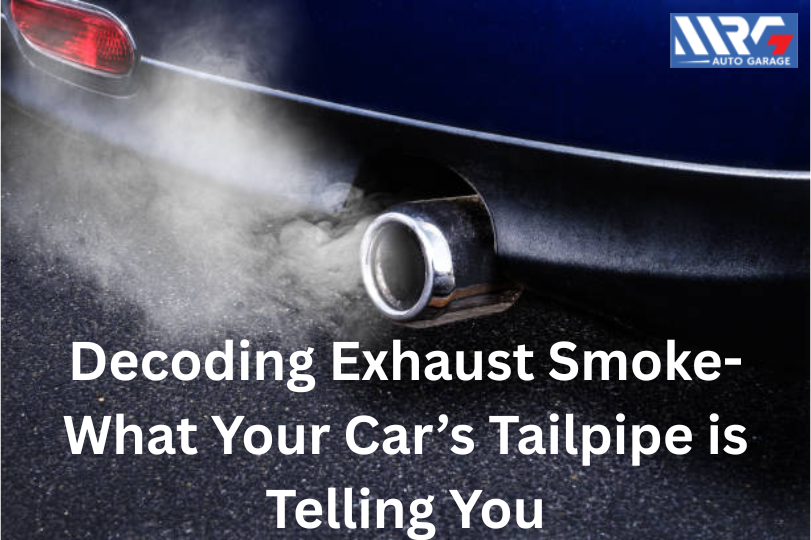That plume of smoke from your exhaust pipe is more than just vapour; it’s a vital message about your engine’s health. While a thin, clear vapour is often normal, distinct colours like white smoke, black smoke, or blue smoke are clear warning signs.
Understanding this colour-coded language can help you diagnose problems early, potentially saving you from costly repairs. This guide will decode car smoke colours, explaining the common causes for each, whether you drive a petrol car or are troubleshooting white smoke in a diesel engine.
The Normal: Clear or Thin White Vapour
Before we dive into problems, let’s establish what’s normal. It’s common to see a thin, white vapour, especially on a cold morning. This is simply water vapour, a natural byproduct of combustion and the condensation in your exhaust system. It should disappear once the engine warms up. This is not the white smoke we’re concerned with. Persistent, thick smoke is the real indicator of an issue.
Thick White Smoke from Exhaust: The Coolant Leaker
When you see a dense, persistent white smoke coming from exhaust, that’s a primary cause for concern. It often has a slightly sweet smell and billows out continuously, even from a warm engine.
What it Means:
This typically indicates that coolant is leaking into the combustion chamber and being burned along with the fuel.
Common Causes:
- Blown Head Gasket: This is the most common culprit. The gasket that seals the engine block to the cylinder head has failed, allowing coolant to seep into the cylinders.
- Cracked Engine Block or Cylinder Head: A more serious and expensive problem caused by overheating, where the engine itself has cracked.
- Faulty Intake Manifold Gasket: In some engines, this gasket can also fail and allow coolant into the combustion area.
This issue applies to both petrol and diesel engines. If you see thick white fumes from exhaust, it’s crucial to stop driving and have your vehicle inspected immediately to prevent severe engine damage.
Specific Case: Cause of White Smoke in Diesel Engine
For diesel engines, thick white smoke when starting a cold engine can also point to:
- Faulty Glow Plugs or Relay: If the glow plugs aren’t working, the engine may not reach the correct temperature for complete combustion, leading to unburned fuel exiting as white smoke. This should clear up as the engine warms.
- Incorrect Injection Timing: If the fuel is being injected at the wrong time in the combustion cycle, it won’t burn efficiently.
Blue or Bluish Smoke from Exhaust: The Oil Burner
Blue smoke from exhaust is a tell-tale sign that your engine is burning oil. You might notice bluish exhaust smoke or bluish white smoke from exhaust during acceleration or when starting the car.
What it Means:
Engine oil is leaking into the combustion chamber and being burned.
Common Causes:
- Worn Valve Seals: This is a classic cause of blue smoke from exhaust pipe on startup. Oil seeps past the worn seals into the cylinder while the engine is off and burns in a puff of smoke when you start the car.
- Worn Piston Rings: The piston rings seal the combustion chamber. When they wear out, oil from the crankcase can get into the cylinders and burn, often causing blue diesel smoke or blue exhaust fumes during acceleration.
- Worn Cylinder Walls: Over time, the cylinders themselves can wear, creating a path for oil to enter the combustion chamber.
Whether it’s bluish smoke from exhaust in a petrol car or blue diesel smoke, the underlying problem is similar: oil is where it shouldn’t be.
Black Smoke from Exhaust: The Fuel Waster
Black smoke exhaust is a clear sign of a rich air-fuel mixture—meaning too much fuel is being burned, or not enough air.
What it Means:
The engine is receiving excess fuel that isn’t being completely burned, resulting in soot (carbon particles) being expelled.
Common Causes:
- Clogged Air Filter: A simple and common fix. A dirty air filter restricts airflow, causing the engine to run rich.
- Faulty Fuel Injectors: Leaky or stuck-open injectors can dump too much fuel into the cylinders.
- Problems with Sensors: Faulty Mass Airflow (MAF) or Oxygen (O2) sensors can send incorrect data to the engine computer, leading to an incorrect fuel mixture.
- Boost Pressure Issues (Turbocharged Engines): A faulty turbocharger or intercooler leak can reduce airflow, creating a rich condition.
Black smoke is more common in diesel engines but can occur in petrol cars too. It hurts fuel efficiency and pollutes the environment.
Grey Smoke from Exhaust: The Less Common Culprit
Grey smoke color can be tricky to diagnose as it sometimes resembles thick white or bluish smoke.
What it Means:
It can point to a few different issues.
- PCV System Failure: A faulty Positive Crankcase Ventilation (PCV) valve can cause excess oil to be sucked into the intake, leading to greyish smoke.
- Automatic Transmission Fluid Leak: In some vehicles, a leaking vacuum modulator can allow transmission fluid to be drawn into the engine and burned, producing grey smoke.
- Turbocharger Seal Failure (Diesel): A very common reason for white smoke in diesel engine that appears greyish is a failing turbocharger seal, which allows oil to leak into the intake system.
If you see persistent grey smoke, a professional diagnosis is best.
What to Do If You See Smoke Coming from Exhaust
If your car is smoking from tailpipe with any coloured smoke other than harmless vapour, take these steps:
- Don’t Ignore It: Coloured smoke is a symptom of a mechanical problem that will likely worsen.
- Check Fluid Levels: Monitor your coolant and engine oil levels for sudden drops.
- Assess the Smell and Timing: Does the white smoke coming out of exhaust smell sweet? Does the blue smoke from exhaust happen on startup? This information is valuable for your mechanic.
- Seek Professional Help: For issues like coolant leaks (muffler smoke white) or oil burning (bluish exhaust smoke), driving can cause catastrophic damage. Have the vehicle towed to a trusted repair centre.
Conclusion: Your Car’s Diagnostic Tool
In summary, what is smoke color telling you? It’s a powerful diagnostic tool.
- Thick White Smoke: Coolant leak (likely a head gasket).
- Blue/Bluish Smoke: Engine oil being burned.
- Black Smoke: Too much fuel (rich mixture).
By paying attention to car smoke colours, you can act early, communicate effectively with your mechanic, and keep your engine running smoothly for years to come. If you see any smoke coming from exhaust that concerns you, the experts at MRG Auto Garage are here to provide a comprehensive diagnosis and professional repair.

Aayush is an Automobile Engineer who repairs and tests cars and their components, applying engineering principles to improve the performance, safety, and efficiency. He works on car engines, brakes, and electrical systems, utilizing computerized models to predict performance and ensure vehicles meet standards.

